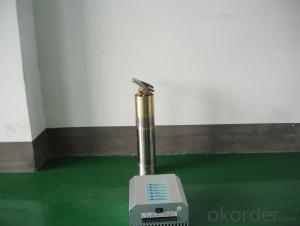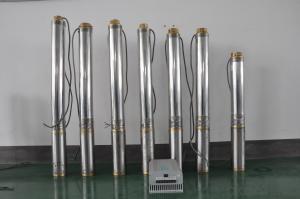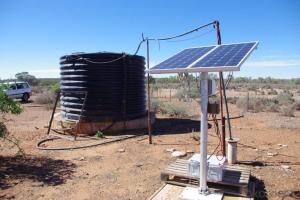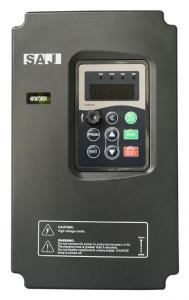DC SUBMERSIBLE PUMPS
- Loading Port:
- China Main Port
- Payment Terms:
- TT OR LC
- Min Order Qty:
- -
- Supply Capability:
- -
OKorder Service Pledge
OKorder Financial Service
You Might Also Like
Item Description :
This superb new addition to our solar fountain range comes with a 10w solar panel,and a powerful fountain pump that is capable of producing fountains of up to 2m in height. As well as being easy to set up and use.Instruction manual is supplied for assembly and maintenance.
Solar Fountain Key Features :
Powered by direct sunlight
No high voltage electric mains required
Safe for children
Max. height of fountain: 2M
Max. flow capacity: 800 L/H(176 GAL)
10W Polycrystalline solar panel included
18V DC brushless pump
Solar Pump Features :
Can produce fountains up to : 2M (tube height) 1.4M (fountain height)
Comes with multiple nozzle accessories
Cable Length : 5M
Solar Panel Features :
10W peak power.
Polycrystalline highly efficient solar panel
Comes mounted in aluminium frame
Comes with ground stake and rotating knob so you can angle your panel toward the sun
What You Will Get :
10W solar panel
Solar pump
Ground Sake
Nozzle accessories
Precautions :
DO NOT alter or change the product itself or its components
Operate pump in freshwater only, never above 50 degrees celsius
Keep away from flammable liquids
Do not connect to any other power supply other than the included
- Q:Can a solar pump be used for water supply in tea estates?
- Yes, a solar pump can be used for water supply in tea estates. Solar pumps use energy from the sun to power the pump, which can effectively draw water from underground sources or nearby water bodies. This sustainable and cost-effective solution can provide a reliable water supply for irrigation and other needs in tea estates.
- Q:Can a solar pump be used for snowmaking in ski resorts?
- Yes, a solar pump can be used for snowmaking in ski resorts. Solar-powered pumps can provide the necessary water flow to snowmaking equipment, allowing ski resorts to produce artificial snow even in remote locations without access to grid electricity. This environmentally friendly solution reduces the resorts' carbon footprint and dependence on fossil fuels while still enabling them to maintain optimal skiing conditions.
- Q:Can a solar pump be used for water treatment plants?
- Yes, a solar pump can be used for water treatment plants. Solar pumps are a sustainable and cost-effective solution for pumping water, and they can be utilized in various applications, including water treatment plants. They can help in pumping water from various sources such as wells, rivers, and lakes, and can be integrated into the water treatment process to ensure a reliable and environmentally friendly water supply.
- Q:What is the maximum pumping depth of a solar pump?
- The maximum pumping depth of a solar pump depends on various factors such as the power of the solar panel, efficiency of the pump, and the specific model being used. However, on average, solar pumps are capable of pumping water from depths ranging between 100 to 300 feet.
- Q:Are there any maintenance requirements for solar pumps?
- Yes, there are maintenance requirements for solar pumps. While solar pumps are generally low maintenance compared to traditional pumps, regular maintenance is still necessary to ensure their optimal performance and longevity. Some of the maintenance requirements for solar pumps include: 1. Cleaning: Regularly clean the solar panels to remove any dust, dirt, or debris that may accumulate on the surface. This will help maximize the solar panels' efficiency and ensure they generate enough power to operate the pump. 2. Inspections: Periodically inspect the pump system, including the motor, pump, and connections, to check for any signs of damage or wear. Look for loose or damaged wires, leaks, or any other issues that may affect the pump's performance. 3. Lubrication: Depending on the type of solar pump, lubrication may be required for the moving parts. Follow the manufacturer's guidelines and recommendations for lubricating the pump to ensure smooth operation. 4. Battery maintenance: If the solar pump includes a battery backup system, regular battery maintenance is essential. This may involve checking the battery levels, cleaning the battery terminals, and replacing batteries if necessary. 5. Professional servicing: It is advisable to have a professional service and inspect the solar pump system at least once a year to ensure everything is in good working order. They can perform more in-depth checks, provide any necessary repairs or replacements, and offer recommendations for optimal performance. By following these maintenance requirements, solar pump owners can ensure their systems operate efficiently and effectively, reducing the risk of breakdowns and extending the lifespan of the pump.
- Q:Can a solar pump be used for water supply in construction sites?
- Yes, a solar pump can be used for water supply in construction sites. Solar pumps use energy from the sun to pump water, making them a sustainable and cost-effective option for providing water in remote or off-grid construction sites. They are easy to install, require minimal maintenance, and can ensure a reliable water supply throughout the construction process.
- Q:Can a solar pump be used for hydroponic systems?
- Yes, a solar pump can be used for hydroponic systems. Solar pumps are commonly used in hydroponics to circulate nutrient-rich water to the plants. They are energy-efficient and environmentally friendly, making them a suitable choice for powering hydroponic systems.
- Q:How do you maintain a solar pump?
- Maintaining a solar pump is essential to ensure its efficiency and longevity. Here are some key steps to follow in order to properly maintain a solar pump: 1. Regular Cleaning: The solar panels should be kept clean and free from any dust, debris, or grime that can affect their performance. Use a soft brush or cloth to gently clean the panels, and avoid using harsh chemicals or abrasive materials that could scratch the surface. 2. Inspect and Secure Connections: Check all the connections, cables, and wiring to ensure they are tightly secured and free from any damage. Loose connections can cause power interruptions or reduce the pump's efficiency. Also, inspect the solar pump controller and inverter for any signs of wear or malfunction. 3. Monitor Pump Performance: Keep an eye on the pump's performance to detect any changes or irregularities. Pay attention to the flow rate, pressure, and any unusual noises. If you notice any issues, it is important to troubleshoot and address them promptly to prevent further damage. 4. Maintain Battery Health: If your solar pump is equipped with a battery, it is crucial to monitor and maintain its health. Check the battery's charge level regularly and ensure it is always within the recommended range. Additionally, clean the battery terminals and keep them corrosion-free. 5. Protect against Extreme Weather: Harsh weather conditions can have a significant impact on a solar pump's performance. During winter, protect the system from freezing temperatures by insulating exposed parts or draining the water from the pump. In areas prone to storms or hail, consider installing protective covers or shields to safeguard the panels and other vulnerable components. 6. Regular Inspections: Schedule routine inspections of your solar pump system. This can be done annually or at regular intervals, depending on the manufacturer's recommendations. Inspections should include a thorough check of all system components, including the pump, panels, wiring, and controller. If you are uncertain about any maintenance tasks, it is advisable to consult with a professional or contact the manufacturer for guidance. By following these maintenance practices, you can ensure that your solar pump operates at its optimal level, providing reliable and efficient water pumping for years to come.
- Q:Can a solar pump be used for water supply in off-grid villages?
- Yes, a solar pump can indeed be used for water supply in off-grid villages. Solar pumps are an excellent solution for areas that lack access to electricity or have unreliable power supply. They operate using solar energy, which is abundant in most off-grid locations. These pumps use photovoltaic panels to generate electricity, which powers the pump to draw water from a source such as a well, river, or lake. Solar pumps have several advantages for off-grid villages. Firstly, they are environmentally friendly as they do not produce greenhouse gas emissions or rely on fossil fuels. They also have lower maintenance costs compared to traditional gasoline or diesel pumps, as they have fewer moving parts and require less frequent servicing. Additionally, solar pumps can be easily installed and operated without the need for extensive infrastructure or technical expertise. By utilizing solar pumps, off-grid villages can have a sustainable and reliable water supply. They can be used to provide clean drinking water, irrigation for crops, or water for livestock. This in turn can enhance the overall quality of life for villagers, improve agricultural productivity, and contribute to economic development. However, it is important to consider the specific needs and conditions of each village before implementing a solar pump system. Factors such as water demand, available sunlight, and water source accessibility must be assessed to ensure the system is designed and sized appropriately. Furthermore, proper maintenance and regular monitoring are crucial for the long-term success and sustainability of the water supply system. In conclusion, a solar pump is a viable and beneficial option for providing water supply in off-grid villages. It offers a sustainable, cost-effective, and environmentally friendly solution that can significantly improve the lives of people in these communities.
- Q:Are there any safety considerations for solar pump installations?
- Yes, there are several safety considerations for solar pump installations. Firstly, it is important to ensure that the solar panels are installed correctly and securely to prevent any potential hazards. This includes proper grounding and protection against lightning strikes. Additionally, the wiring and electrical connections should be done by a qualified professional to avoid any electrical hazards. It is crucial to follow the manufacturer's guidelines and local electrical codes to ensure a safe installation. Furthermore, it is essential to protect the solar pump system from overheating. This can be achieved by providing adequate ventilation and shading to prevent excessive heat buildup. Moreover, regular maintenance and inspections are necessary to identify any potential issues or malfunctions that could pose safety risks. This includes checking for loose connections, damaged components, and any signs of wear and tear. Lastly, it is important to have proper signage and safety precautions in place to warn individuals of the potential hazards associated with the solar pump system. This can include signage indicating high voltage areas, safety barriers, and clear instructions on how to safely operate and maintain the system.
1. Manufacturer Overview |
|
|---|---|
| Location | |
| Year Established | |
| Annual Output Value | |
| Main Markets | |
| Company Certifications | |
2. Manufacturer Certificates |
|
|---|---|
| a) Certification Name | |
| Range | |
| Reference | |
| Validity Period | |
3. Manufacturer Capability |
|
|---|---|
| a)Trade Capacity | |
| Nearest Port | |
| Export Percentage | |
| No.of Employees in Trade Department | |
| Language Spoken: | |
| b)Factory Information | |
| Factory Size: | |
| No. of Production Lines | |
| Contract Manufacturing | |
| Product Price Range | |
Send your message to us
DC SUBMERSIBLE PUMPS
- Loading Port:
- China Main Port
- Payment Terms:
- TT OR LC
- Min Order Qty:
- -
- Supply Capability:
- -
OKorder Service Pledge
OKorder Financial Service
Similar products
New products
Hot products
Hot Searches
Related keywords




























